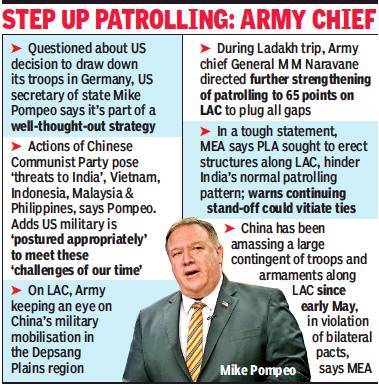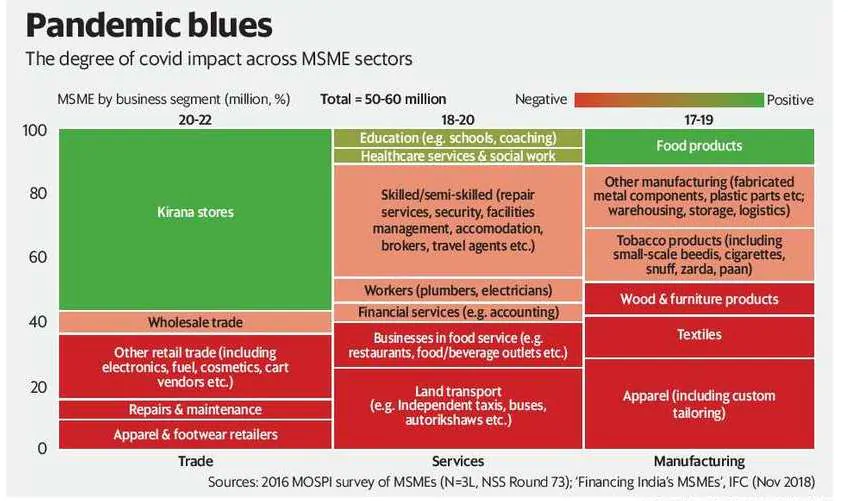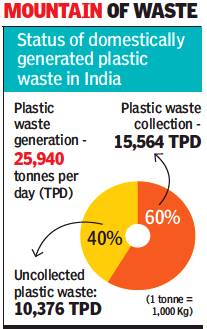Contents
- US: Moving Europe troops to counter China threat to India
- The retool imperative for small businesses to survive
- Framework for producers to manage plastic waste
- Illegal wildlife trades a global threat: FATF report
- IN-SPACe to be new space industry regulator
- UN chief expects all members to abide by UNSC resolutions
US: MOVING EUROPE TROOPS TO COUNTER CHINA THREAT TO INDIA
Focus: GS-II International Relations
Why in news?
- The U.S. Secretary of State said that China’s “threats to India” and Southeast Asia were among the main reasons for the US’s move to reduce its troops in Europe.
- China had been “amassing” troops and armaments along the Line of Actual Control (LAC) since May according to the Government of India
U.S. Moving troops to help face Chinese Aggression
- US President Donald Trump recently announced that the US would be reducing troops from Germany, a decision that’s angered EU countries.
- The actions of the Chinese Communist Party meant there were “threats to India” and countries like Vietnam, Indonesia, Malaysia, Philippines and the South China Sea.
- Pompeo’s marking out of China’s threats to its neighbours as a priority represents a significant policy statement and security posture.

US, EU to start talks over threats from China
- U.S. Secretary of State announced that the US and the EU would start a dialogue on China and the challenges it poses.
- It would help the trans-Atlantic alliance to build a common understanding of the threat posed by China.
Indian Government on Build of Chinese Forces along PLA
- Indian Government accused the People’s Liberation Army (PLA) of violating the 1993 agreement between India and China that committed both sides to “minimum levels” of deployment.
- This is the first time the government has formally acknowledged the scale of the build-up along the LAC since early May.
- The government also made it clear that it believes the PLA movement in the summer of 2020 has been different from past years.
- The MEA said that the “deployment of large body of troops and changes in behavior has also been aggravated by unjustified and untenable claims. The recent shift in the Chinese position on the Galwan Valley is one example.”
- Indian Government called the meeting of diplomats in the Working Mechanism for Consultation & Coordination on India-China Border Affairs (WMCC).
-Source: Times of India, The Hindu
THE RETOOL IMPERATIVE FOR SMALL BUSINESSES TO SURVIVE
Focus: GS-III Indian Economy
Introduction
- The micro, small and medium enterprise (MSME) industry forms the backbone of India. Approximately 60 million MSMEs employ a workforce well over 110 million and contribute to about 30% of India’s GDP.
- According to a survey in 2018, more than 50% of all income earners in India are self-employed across income groups and therefore, the development of the MSME sector is critical to India’s growth aspirations.

Issues with the Development of MSMEs
The traditional challenges faced by MSMEs included:
- limited access to finance,
- infrastructure bottlenecks,
- dearth of skills and innovation
- regulatory constraints.
Ease of doing business related to exports is low coupled with dispute resolution and high entry and exit costs.
There has been a genuine softening of demand during the lockdown, especially in sectors like retail, travel and tourism and manufacturing.
Way Forward
- Apply strong handbrakes to reduce cash burn and reset the cost structure, including renegotiation of rents and contracts, rebalancing of senior team salary costs and plugging all discretionary spends.
- Each MSME should think hard of which product lines they can add to their existing portfolio, both to survive during the crisis as well as to diversify, after the crisis.
- MSMEs should aspire to build a scaled exports portfolio to serve markets that are recovering faster, such as Europe and South-East Asia.
- Several B2C (business-to-consumers) MSMEs should be aggressively participating in e-commerce platforms to leverage the 100% plus growth that e-commerce has seen.
- MSMEs can leverage the current situation which has forced them to adapt to the work-from-home model, causing them to let go of their offices and or at least reducing the size of their office premises. This can be used to increase their agility, access to talent pools and open up new business models in the post-covid era.
- There should be incentives for MSMEs to aspire and expand into MNCs.
-Source: Livemint
FRAMEWORK FOR PRODUCERS TO MANAGE PLASTIC WASTE
Focus: GS-III Environment and Ecology
Why in news?
Centre has come out with a framework where it suggests three different models to be adopted by manufacturers, importers and brand owners to handle the waste under supervision of a central authority.
Highlights of the Framework
- Introduction of a system of plastic credit, establishing Producer Responsibility Organisations (PROs) and setting up a fee-based mechanism are three different models which will be available to producers of plastic products, including FMCG companies, under this framework.
- The proposed uniform Extended Producers Responsibility (EPR) framework, released by Union environment ministry this week, also has provisions to impose penalties on producers if they fail to meet their targeted collection. This money will be used for creating infrastructure for plastic waste management.
- A single national registry will be created to enlist all stakeholders. It will improve monitoring and help bring transparency in the plastic waste management system in the country where 40% of its daily waste remains uncollected, posing a threat to environmental and human health.
- The monitoring of the entire mechanism of the EPR will be the responsibility of the Central Pollution Control Board (CPCB).
- A graded approach for achieving the targets will be recommended, starting with 30% in the first year and moving up to 90% in five years.
More Plastic per Person in India

- India is struggling to dispose its growing quantities of plastic waste given how ubiquitous it has become — from our tooth brushes to debit cards.
- India generates close to 26,000 tonnes of plastic a day, according to a CPCB estimate from 2012.
- Worse, a little over 10,000 tonnes a day of plastic waste remains uncollected.
- Uncollected plastic waste eventually ends up in the natural environment — in our seas and oceans or piling up on our lands.
Rules regarding Plastic Waste Management in the Past
- The 2016 Plastic Waste Management Rules were an attempt to improve legislation, and state that every local body has to be responsible for setting up infrastructure for segregation, collection, processing and disposal of plastic waste.
- Additionally, the rules, amended in 2018, introduced the concept of extended producer responsibility, according to which the producers (manufacturers, importers and those using plastic in packaging) as well as brand owners would be held responsible for collecting the waste their products generate.
-Source: Times of India
ILLEGAL WILDLIFE TRADE A GLOBAL THREAT: FATF REPORT
Focus: GS-III Environment and Ecology
Why in news?
In its first global report on the illegal wildlife trade, the Financial Action Task Force (FATF) has described it as a global threat, which also has links with other organised crimes like modern slavery, drug trafficking and arms trade.
Highlights of the FATF Money Laundering and the Illegal Wildlife Trade Report
Complex fraud and tax evasion
- The report said criminals are frequently misusing the legitimate wildlife trade, as well as other import-export type businesses, as a front to move and hide illegal proceeds from wildlife crimes.
- The study has highlighted the growing role of online marketplaces and mobile and social media-based payments to facilitate movement of proceeds warranting a coordinated response from government bodies, the private sector and the civil society.
- The FATF found that jurisdictions often did not have the required knowledge, legislative basis and resources to assess and combat the threat posed by the funds generated through the illegal trade.
- Front companies, often linked to import-export industries, and shell firms are used for the movement of goods and trans-border money transfers. Another common trend is the misuse of front companies with links to the legal wildlife trade, said the report.
India on Tackling the Issues
The report noted that in 2012, India amended the Prevention of Money Laundering Act removing a value threshold — of ₹30 lakh and above — that was earlier applicable to the wildlife trade predicates.
Prevention of Money Laundering Act
- Prevention of Money Laundering Act, 2002 is an Act of the Parliament of India enacted by the NDA government to prevent money-laundering and to provide for confiscation of property derived from money-laundering.
- The act was amended in the year 2005, 2009 and 2012.
- In 2017, the Supreme Court has set aside a clause in the Prevention of Money Laundering Act, which made it virtually impossible for a person convicted to more than three years in jail to get bail if the public prosecutor opposed it.
The PMLA seeks to combat money laundering in India and has three main objectives:
- To prevent and control money laundering
- To confiscate and seize the property obtained from the laundered money; and
- To deal with any other issue connected with money laundering in India.
Way Forward According to Report
- The report says financial probe is key to dismantling the syndicates involved, which can in turn significantly impact the associated criminal activities.
- The report recommended that jurisdictions should consider implementing the good practices, as observed during the study, which include providing all relevant agencies with the necessary mandate and tools; and cooperating with other jurisdictions, international bodies and the private sector.
- The FATF also said legislative changes were necessary to increase the applicability of anti-money laundering laws to the illegal wildlife trade-linked offences.
-Source: The Hindu
IN-SPACE TO BE NEW SPACE INDUSTRY REGULATOR
Focus: GS-III Industry and Infrastructure, Science and Technology
Why in news?
IN-SPACe to be new space industry regulator, says ISRO chief.
IN-SPACe
IN-SPACe and ISRO
- IN-SPACe, or Indian Space Promotion and Authorisation Centre, is touted as the body that will ensure a level playing field for Indian industry in a fast-growing global space sector.
- It will function autonomously and parallel to ISRO.
- IN-SPACe, the new entity of the Department of Space, will have its own chairperson and board, and have its own directorates for technical, legal, safety and security, monitoring and activities promotion.
- IN-SPACe will regulate and promote building of routine satellites, rockets and commercial launch services through Indian industry and startups.
- This restructuring will allow ISRO to allocate more time and resources for R&D endeavours.
[These activities were largely the domain of the 50-year-old Indian Space Research Organisation (ISRO) until now but the change will not upset the core research activity of ISRO.]
IN-SPACe and NSIL
- The year-old NSIL [NewSpace India Ltd] will be strengthened and empowered with a larger role in what the government has called the new open and inclusive space sector.
- It will work with IN-SPACe and enable industry consortia to take on some of the activities of ISRO.
- These include launch vehicles and satellite production, launch services and space-based services.
Navigation policy
- A new Satellite Navigation Policy, which has a strategic military element to it, is being proposed.
- The older ones, namely Remote Sensing Data Policy and the SatCom Policy of 2000, are being revised.
- These are apart from a proposed policy for space activities that has seen a draft.
Background Information
New Space India Limited (NSIL)
- NSIL functions under the administrative control of Department of Space (DOS).
- It aims to commercially exploit the research and development work of ISRO Centres and constituent units of DOS.
- The NSIL would enable Indian Industries to scale up high-technology manufacturing and production base for meeting the growing needs of the Indian space programme.
ANTRIX
- Antrix Corporation Limited (ACL), Bengaluru is a wholly-owned Government of India Company under the administrative control of the Department of Space.
- It is as a marketing arm of ISRO for promotion and commercial exploitation of space products, technical consultancy services and transfer of technologies developed by ISRO.
- Antrix is engaged in providing Space products and services to international customers worldwide.
-Source: The Hindu
UN CHIEF EXPECTS ALL MEMBERS TO ABIDE BY UNSC RESOLUTIONS
Focus: GS-II International Relations
Why in news?
UN Secretary-General expects all member states to “live up” to their obligations under the relevant Security Council resolutions, after a U.S. report noted that Pakistan remains a safe haven for terrorists as it did not take actions against JeM founder Masood Azhar.
U.S. State Department report on Pakistan
- The U.S. State Department in its 2019 Country Reports on Terrorism said Pakistan remained a “safe harbor” for regionally-focused terrorist groups and that the suspension of U.S. aid to the country remained in effect throughout 2019.
- The report said Pakistan took “modest steps” in 2019 to counter terror financing and restrain India-focused militant groups from conducting large-scale attacks following the Pulwama attack.
- It further said that Pakistan took action against some externally focused groups, including Lashkar e-Taiba founder Hafiz Saeed.
- However, it did not take action against Jaish-e-Mohammed founder and UN-designated terrorist Azhar and 2008 Mumbai attack ‘project manager’ Sajid Mir.
Sanctions on Terrorists in Pakistan
- The UN 1267 Sanctions Committee designated Azhar as a global terrorist on 2019, slapping an arms embargo, asset freeze and travel ban on him, 10 years after India’s first move to have him blacklisted at the UN.
- The UN 1267 Sanctions Committee designated Azhar as a global terrorist in May last year, slapping an arms embargo, asset freeze and travel ban on him, 10 years after India’s first move to have him blacklisted at the UN.
- In 1999, the UNSC Committee was established pursuant to Resolution 1267 (1999), which imposed a limited air embargo and asset freeze on the Taliban. Over time, measures became a targeted asset freeze, travel ban and arms embargo against designated individuals and entities.
In 2011 the UNSC Committee split into two.
- The 1267 Committee was henceforth known as the Al-Qaida Sanctions Committee, mandated to oversee implementation of the measures against individuals and entities associated with Al-Qaida.
- A separate Committee was established pursuant to resolution 1988 (2011) to oversee implementation of the measures against individuals and entities associated with the Taliban.
-Source: The Hindu




